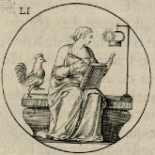On autograph letters
One of my motivations for creating this blog was the desire to have a flexible, web-based, open-access platform for publishing illustrated mini-essays around objects that capture my attention and curiosity. One category of such objects is that of autograph letters by early modern authors which survive, more or less “hidden,” in innumerable collections around the world. I first became aware of the magnitude of these dispersed treasures in 2015-16, while trying to find extant manuscripts by the seventeenth-century French poet Nicolas Boileau-Despréaux. Pieces turned up not only in Paris but also at the British Library in London, at the ÖNB in Vienna, at the Bodmer Foundation in Geneva, at municipal libraries in Nantes and Lille, at colleges and universities in Maine and Massachusetts, etc. Some of them were of dubious authenticity, impelling me to investigate their provenance and to delve into the mysterious nineteenth-century autograph market. Meanwhile in France, the Aristophil scandal demonstrated all too clearly that many such manuscripts were still in private hands today and could even become subject to greed and fraud.
Like most literary scholars in my generation, I used to have barely an inkling of the existence and history of these autograph collections and had received no relevant initiation or training. For decades I had been using print editions of writers’ correspondences (such as those of Boileau, Racine, Bussy-Rabutin, Mlle de Scudéry, or Mme de Lafayette) rather uncritically, without questioning their completeness and reliability. And to be sure, the fragmentation, invisibility, and/or inaccessibility of these widely scattered papers make them difficult and frustrating to study. Nevertheless, surviving collections of early modern manuscripts, whether in public or private hands, are an undeniably important segment of cultural heritage and not only deserve but call for scholarly attention and analysis. This work has become somewhat less onerous thanks to twenty-first-century technology, from email and online finding aids and catalogs (of libraries but also auctions) to digital photography.
Personal inspection of the physical letters remains, however, a necessity, as well as a privilege and a pleasure. I began by exploring some major repositories in my geographical vicinity, especially Princeton University, the New York Public Library, the Morgan Library & Museum, Haverford College, and the Historical Society of Pennsylvania. Fortunately, many institutions have recently liberalized their policies regarding the production and use of images of objects in their collections, increasingly allowing not only the taking of photos for research purposes but also, in most cases, their dissemination on academic websites and blogs such as this one.
It is the combination of these various factors that has led, so far, to the following posts (listed in chronological order of publication):
A letter from Racine to Boileau (Haverford College)
Saving Madame de Graffigny (Historical Society of Pennsylvania)
Rubens and the King of France (Haverford College)
The autograph and its double (Historical Society of Pennsylvania / Bibliothèque nationale de France)
Anne Le Fèvre Dacier in America (Historical Society of Pennsylvania / Princeton University / Bowdoin College)
Pierre-Daniel Huet in New York (New York Public Library)
